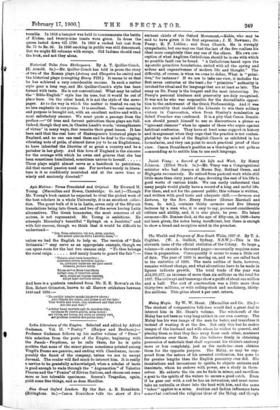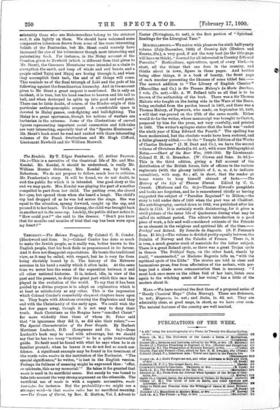Malay Magic. By W. W. Skeat. (Macmillan and Co. 21s.)—
The student of comparative folk-lore would find a great deal to interest him in Mr. Skeat's volume. The witchcraft of the Malay has not been so very long extinct in our own country. The Malay has his wax image of the man he bates, and transfixes it instead of wasting it at the fire. Not only this but he makes images of the husband and wife whom he wishes to quarrel, and placing them so that they face away from each other, murmurs incantations over them. He also believes firmly in obtaining possession of materials that shall represent his victim's anatomy more or less completely, just as the medicine - man obtains them for the opposite purpose. The Malay, as may be sup- posed from the nature of his arrested civilisation, has gone to far greater lengths than the English peasantry ever did. His incantations and invocations to spirits, to objects animate and inanimate. whom he endows with power, are a study in them- selves. He exhorts the tin ore he finds in mines, and sacrifices a goat to the spirits of the waters to secure a good catch. Even if he goes out with a rod he has an invocation, and must never take an umbrella or shoes into the boat with him, and the same " taboo" applies to a mine. Arabian and Indian influences have somewhat confused the religious ideas of the Malay, and though
ostensibly those who are Mahommedans belong to the strictest sect, it sits lightly on them. We should have -welcomed some comparative inferences drawn from some of the more interesting beliefs of the Peninsular, but Mr. Skeat could scarcely have increased the size of his voluminous though most interesting and painstaking book. For instance, in the Malay account of the Creation given to Newbold (which is different from that given to Mr. Skeat), the Caucasus Mountains were intended as a chain to strengthen the earth, and keep off winds and evil beasts, and a people called Yajuj and Majuj are boring through it, and when they accomplish their task, the end of all things will come. This reminds us of the final triumph of Loki and the gods of his following against the Scandinavian hierarchy. And in the account given to Mr. Skeet a great serpent is mentioned. He is only an incident, it is true, but his head reaches to heaven and his tail to hell, and when destroyed he splits up into good and evil genii. There can be little doubt, of course, of the Hindoo origin of this particular anthropomorphic serpent. A considerable space is devoted to Malay games, cock-fighting and bull-fighting. The Malay is a great sportsman, though his notions of warfare are barbarian in the extreme. Some of the illustrations of carved figures representing important social ceremonies and folk-tales are very interesting, especially that of the " Spectre Huntsman." Mr. Skeet's book must be read and ranked with those interesting volumes of Sir Frank Swettenham and Mr. Hugh Clifford, Lieutenant Newbold and Sir William Maxwell.







































 Previous page
Previous page